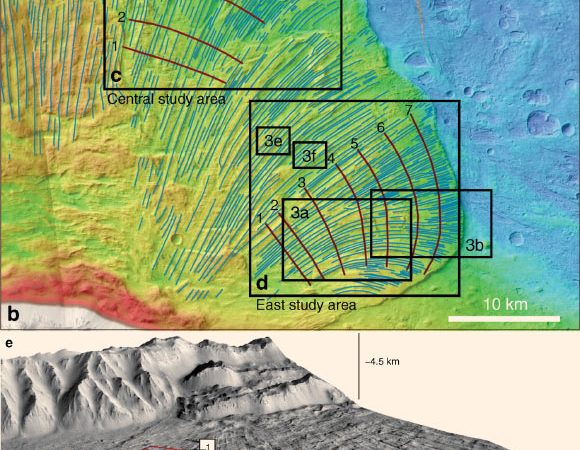Unusually large and long ridges documented in massive landslides across our Solar System are commonly associated with the presence of ancient ice layers. To better understand how these features formed, an international team of planetary scientists analyzed 3D images of an extensive landslide in the Valles Marineris region of Mars. Their findings show the unique structures could have formed at high speeds of up to 224 mph (360 kmh) due to underlying layers of fragmented rocks; this challenges the idea that underlying layers of ice can only explain such long ridges.
Source: Sci News
“Landslides on Earth, particularly those on top of glaciers, have been studied by scientists as a proxy for those on Mars because they show similarly shaped ridges and furrows, inferring that Martian landslides also depended on an icy substrate,” said study lead author Giulia Magnarini, a PhD student in the Department of Earth Sciences at University College London.
“However, we’ve shown that ice is not a prerequisite for such geological structures on Mars, which can form on rough, rocky surfaces.”
“This helps us better understand the shaping of Martian landscapes and has implications for how landslides form on other planetary bodies including Earth and the Moon.”
Magnarini and colleagues used images from NASA’s Mars Reconnaissance Orbiter to analyze some of the best-defined landslides remotely.
The scientists analyzed cross-sections of the surface in Coprates Chasma in Valles Marineris to investigate the relationship between the height of the ridges and width of the furrows compared to the thickness of the landslide deposit.
The structures were found to display the same ratios as those commonly seen in fluid dynamics experiments using sand, suggesting an unstable and dry rocky base layer is as feasible as an icy one in creating the vast formations.
Where landslide deposits are thickest, ridges form 197 feet (60 m) high and furrows are as wide as eight Olympic-sized swimming pools end-to-end.
The structures change as deposits thin out towards the edges of the landslide. Here, ridges are shallow at 33 feet (10 m) high and sit closer together.
“The Martian landslide we studied covers an area larger than Greater London and the structures within it are huge,” said co-author Dr. Tom Mitchell, also from the Department of Earth Sciences at University College London.
“Earth might harbor comparable structures but they are harder to see and our landforms erode much faster than those on Mars due to rain.”
“While we aren’t ruling out the presence of ice, we know is that ice wasn’t needed to form the long run-outs we analyzed on Mars.”
“The vibrations of rock particles initiate a convection process that caused upper denser and heavier layers of rock to fall and lighter rocks to rise, similar to what happens in your home where warmed less dense air rises above the radiator. This mechanism drove the flow of deposits up to 40 km away from the mountain source and at phenomenally high speeds.”
“This work on Martian landslides relates to further understanding of lunar landslides such as the Light Mantle Avalanche I studied in the valley of Taurus-Littrow during Apollo 17 exploration and have continued to examine using images and data collected more recently from lunar orbit,” added University of Wisconsin Madison’s Professor Harrison Schmitt, an Apollo 17 astronaut who walked on the Moon in December 1972 and completed geologic fieldwork while on the lunar surface.
“Flow initiation and mechanisms on the Moon may be very different from Mars; however, comparisons often help geologists to understand comparable features.”
Source: Sci News

































Leave a Comment
You must be logged in to post a comment.